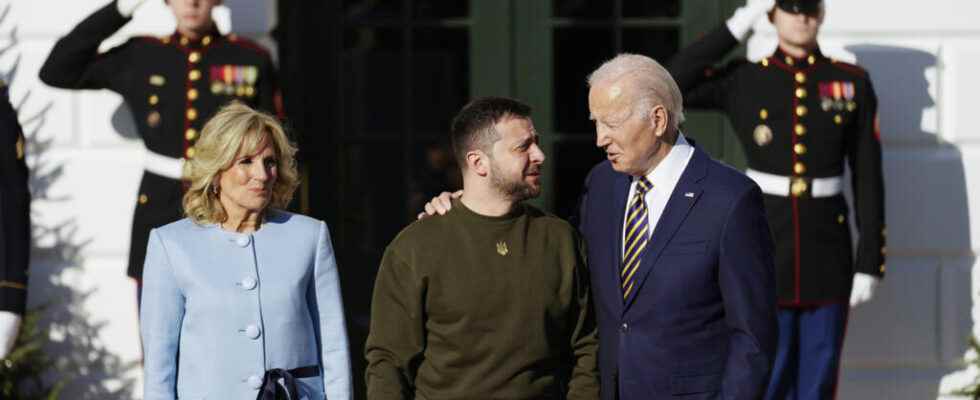A year to the day after the start of the Russian invasion, the United States on Friday announced a new round of military aid to Ukraine worth a total of $2 billion. The latest announcements from the Pentagon, reported in the press in the United States, report upcoming deliveries of additional ammunition for artillery and for Himars rocket launcher systems, as well as drones. The largest donor country to Ukraine, the United States has delivered or promised more than $32 billion in various weapons to Kiev forces since the start of the Russian offensive on February 24, 2022.
At the same time, the White House announces that it will once again toughen its sanctions against Moscow. A new salvo of measures has been adopted, targeting sectors such as banks and the defense industry, aiming in particular to reduce Moscow’s access to sensitive technologies such as semiconductors. These sanctions will affect more than 200 individuals and entities, including Russian and third-country actors across Europe, Asia and the Middle East who support Russia’s war effort.
Biden-Zelensky: A partnership forged by war »
This year of war is recounted in the New York Times through the lens of its photographers. In One, a photo shows Ukrainian soldiers, muddy boots, perched on a tank, smiles or closed faces. Throughout the pages, the daily presents the pictures of its reporters on the front lines, in remote villages, or at funerals. ” Indelible images of war “, title the newspaper.
The daily also looks at the tandem formed by Joe Biden and Volodymyr Zelenskydescribed as ” a partnership forged by war “or even as a relationship” hectic ” but “ solid “. 35 years separate the two men with very different styles. The first, 80, is a career politician. The other, 45, a former satirical comedian catapulted into a warlord. The article recounts the repeated phone calls between the two presidents during which Volodymyr Zelensky regularly urges his American counterpart to unblock ” more help and faster for Ukraine. Journalists dare to make a comparison with the duo formed by Winston Churchill and Franklin Roosevelt at the start of the Second World War.
In the columns of washington postan editorialist considers that “ the Biden administration is wrong: time is not on Kyiv’s favor “, believing that if the war drags on it would play into Vladimir Putin’s game. Ukraine, already a battleground, will find it difficult to recover from the destruction inflicted by Russia on infrastructure, energy production and agricultural facilities. “ Next year there may be no more Ukraine to save “, he concludes.
► Read also: A year of war in Ukraine seen from Russia with the RFI correspondent
” energy divorce »
For his part, the log Politico in a long paper relates the American strategy to thwart the plans of Vladimir Putin in Ukraine, via the sharing of intelligence, but also the constitution of a broad international coalition against Moscow. Finally, the daily analyzes how the United States replaced Russia as the main supplier of gas and oil to Europe, leading to a ” energetic divorce between Moscow and the countries of the Old Continent.
Finally, The Intercept take advantage of the anniversary of the start of the war in Ukraine to relay a campaign led by several non-governmental organizations demanding more transparency from the authorities on the sale or transfer of arms abroad. The United States are the world’s leading arms sellers, their exports reaching almost 40% of the international market. ” The war in Ukraine proved that arms transfers could be transparent. Why wouldn’t this be the norm with other countries? asks the investigative magazine.
► Read also : Why Eastern European economies are suffering more from the war in Ukraine
Latin American non-alignment
In the south of the continent, the countries of Latin America, like the rest of the world, have been hard hit by inflation which has been galloping for a year. The Colombian daily El Tiempo draw a economic assessment of the consequences of the war for Latin American countries. A difficult year for farmers on the continent, faced with rising fertilizer prices, mainly from Ukraine and Russia.
This increase in production costs was finally offset by agricultural exports at record prices for many Latin American countries, underline portfolio. Brazil saw a 36% increase in agricultural exports. In addition, the global energy crisis, caused by the war, has favored the countries exporting oil, gas and coal on the continent, at the head of which are Colombia, Venezuela or Brazil.
Most Latin American countries have opted for neutrality in this conflict. The Argentinian newspaper Pagina12returns to the successive refusals of several Latin American leaders to send arms to Ukraine. The United States had nevertheless proposed a deal “ tantalizing “: replace the aging armaments delivered to Ukraine with new equipment ” made in USA “. From Colombia to Argentina, via Brazil, all refused, in the name of non-alignment, but also in the face of the reluctance of their public opinion.
► To read also: More than 15 million Colombians victims of food insecurity, warns the WFP
